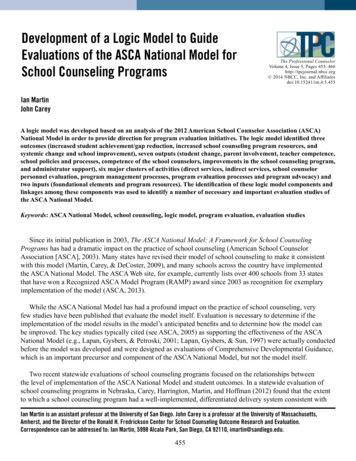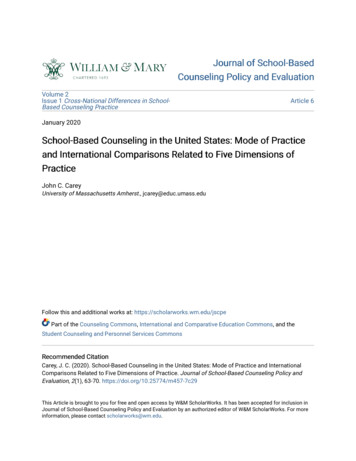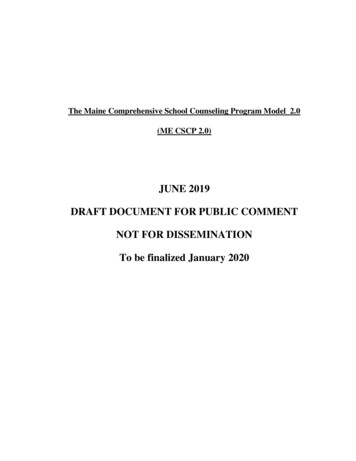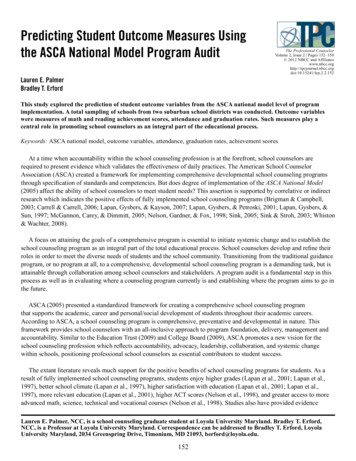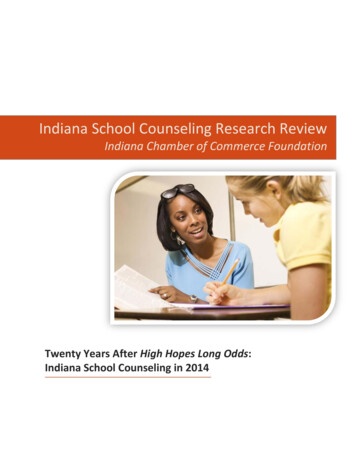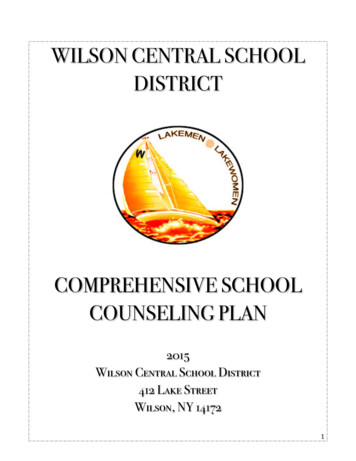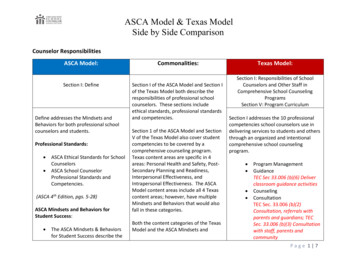
Transcription
ASCA Model & Texas ModelSide by Side ComparisonCounselor ResponsibilitiesASCA Model:Section I: DefineDefine addresses the Mindsets andBehaviors for both professional schoolcounselors and students.Professional Standards: ASCA Ethical Standards for SchoolCounselorsASCA School CounselorProfessional Standards andCompetencies.(ASCA 4th Edition, pgs. 5-28)ASCA Mindsets and Behaviors forStudent Success: The ASCA Mindsets & Behaviorsfor Student Success describe theCommonalities:Section I of the ASCA Model and Section Iof the Texas Model both describe theresponsibilities of professional schoolcounselors. These sections includeethical standards, professional standardsand competencies.Section 1 of the ASCA Model and SectionV of the Texas Model also cover studentcompetencies to be covered by acomprehensive counseling program.Texas content areas are specific in 4areas: Personal Health and Safety, PostSecondary Planning and Readiness,Interpersonal Effectiveness, andIntrapersonal Effectiveness. The ASCAModel content areas include all 4 Texascontent areas; however, have multipleMindsets and Behaviors that would alsofall in these categories.Both the content categories of the TexasModel and the ASCA Mindsets andTexas Model:Section I: Responsibilities of SchoolCounselors and Other Staff inComprehensive School CounselingProgramsSection V: Program CurriculumSection I addresses the 10 professionalcompetencies school counselors use indelivering services to students and othersthrough an organized and intentionalcomprehensive school counselingprogram. Program ManagementGuidanceTEC Sec 33.006 (b)(6) Deliverclassroom guidance activitiesCounselingConsultationTEC Sec. 33.006 (b)(2)Consultation, referrals withparents and guardians; TECSec. 33.006 (b)(3) Consultationwith staff, parents andcommunityPage 1 7
ASCA Model & Texas ModelSide by Side Comparisonknowledge, skills and attitudesstudents need to achieveacademic success, college andcareer readiness andsocial/emotional development.The standards are based on asurvey of research and bestpractices in student achievementfrom a wide array of educationalstandards and efforts. There are29 Behavior Standards and 6Mindset Standards.(ASCA 4th Edition, pgs. 1-5) Behaviors covers all SB 11 and HB 18specific topics required by Texas law. CoordinationTEC (b)(4) Coordinate people,resources in the school, home,communityStudent AssessmentAdvocacyLeadershipProfessional BehaviorProfessional StandardsSection V provides the scope andsequence for the Texas Model forComprehensive School CounselingPrograms. The content areas include:(TEC Sec. 33.005 (1) Guidance Curriculum;TEC Sec. 33.006 (b)(6) Deliver classroomguidance activities; TEC Sec. 33.007Counseling Regarding Post-SecondaryPlanning) Intrapersonal EffectivenessInterpersonal EffectivenessPostsecondary Education andCareer Readiness Personal Health and Safety(Texas Model 5th Edition, pgs. 129-153)Page 2 7
ASCA Model & Texas ModelSide by Side ComparisonProgram DevelopmentASCA Model:Commonalities:Section II: ManageSection II of the ASCA Model and SectionsII and III of the Texas Model both coverfoundational aspects of a comprehensivecounseling model. This includes programmissions and vision for both models, andthe Program Planning portion of Section IIin the ASCA Model provides a programimplementation cycle as does Section II ofthe Texas Model.Program Focus: BeliefsMission StatementVision Statementth(ASCA 4 Edition, pgs. 29-32)Additionally, Section III of the TexasProgram Planning:Model and the Program Planning portionTEC Sec. 33.006 (b)(1) Planning, implementing and of the ASCA Model addressesevaluatingimplementing a data-drivencomprehensive counseling program. Data (Participation, Mindsets &Behaviors, Outcomes)Data elements of both models include Annual Student Outcome Goalsreviewing academic/educational, School Data Summaryattendance, and behavioral campus data Program Results Datato plan needed interventions. Action PlansClassroom and Group Mindsets & The ASCA Model includes specificBehavior Action Planimplementation documents that adheresTexas Model:Section II: Program Implementation CycleSection III: Foundational ComponentsSection II provides an explanation of theprogram implementation cycle. Schoolcounselors can use this section to planthe process of program development andimplementation.TEC Sec. 33.006 (b)(1) Planning, implementing andevaluating OrganizingPlanningDesigningImplementing(Texas Model 5th Edition, pgs. 33-44)Section III outlines the foundationalcomponents including:TEC Sec. 33.006 (b)(1) Planning, implementing andevaluating Mission statementProgram DefinitionPage 3 7
ASCA Model & Texas ModelSide by Side ComparisonTEC Sec. 33.006 (b)(6) Deliver classroomguidance activitiesClosing-the-Gap ActionPlan/Results Report Lesson Plansto the Texas Model programimplementation cycle. Program RationaleProgram AssumptionsProgram GoProgram Evaluation(Texas Model 5th Edition, pgs. 45-73)TEC Sec. 33.006 (b)(6) Deliver classroomguidance activities; TEC Sec. 33.007Counseling Regarding Post-SecondaryPlanning Calendars Advisory CouncilTEC Sec. 33.006 (b)(3) Consultation withstaff, parents and community; TEC (b)(4)Coordinate people, resources in theschool, home, community Annual Administrative Conference(ASCA 4th Edition, pgs. 32-76)Page 4 7
ASCA Model & Texas ModelSide by Side ComparisonProgram DeliveryASCA Model:Commonalities:Section III: DeliverSection III of the ASCA Model along withSection IV of the Texas Model addressdirect students services. While theterminology is similar, yet different, bothmodels address Guidance Curriculum orInstruction, Responsive Services orCounseling, and Individual Planning orAppraisal and Advisement. All of theseareas are direct student services.Direct Student Services: Instruction(TEC Sec. 33.005 (1) GuidanceCurriculum; TEC Sec. 33.006 (b)(6) Deliverclassroom guidance activities; TEC Sec.33.007 Counseling Regarding PostSecondary Planning) Appraisal and AdvisementTEC Sec. 33.005 (3) Individual Planning;TECSec. 33.006 (b)(5) Interpretstandardized test results; TEC Sec. 33.007Counseling Regarding Post-SecondaryPlanning) Counseling(TEC Sec. 33.005 (2) Responsive Services(ASCA 4th Edition, pgs. 77-81)Both models address indirect studentservices through system supports, whichincludes consultation, collaboration, andreferrals.Additionally, both models suggest aprogram balance of 80% direct studentservices and 20% indirect studentservices and a limitation of noncounseling duties.Texas Model:Section IV: Four Service DeliveryComponentsSection IV is a detailed focus on the fourcomponents of the delivery system: Guidance Curriculum(TEC Sec. 33.005 (1) GuidanceCurriculum; TEC Sec. 33.006 (b)(6) Deliverclassroom guidance activities; TEC Sec.33.007 Counseling Regarding PostSecondary Planning) Responsive Services(TEC Sec. 33.005 (2) Responsive Services Individual Planning(TEC Sec. 33.005 (3) Individual Planning;TEC Sec. 33.006 (b)(5) Interpretstandardized test results; TEC Sec. 33.007Counseling Regarding Post-SecondaryPlanning) System Support(TEC Sec. 33.005 (4) System Support Non-Counseling DutiesProgram Balance(Texas Model 5th Edition, pgs. 75-127)Page 5 7
ASCA Model & Texas ModelSide by Side ComparisonIndirect Student Services:TEC Sec. 33.006 (b)(2) Consultation, referrals withparents and guardians Consultation(TEC Sec. 33.005 (4) System Support, Collaboration(TEC Sec. 33.005 (4) System Support Referrals(TEC Sec. 33.005 (4) System Support(ASCA 4th Edition, pgs. 81-83)Page 6 7
ASCA Model & Texas ModelSide by Side ComparisonProgram AssessmentASCA Model:Commonalities:Texas Model:Section IV: AssessSection IV of the ASCA Model and SectionIII of the Texas Model both coverprogram evaluation and assessment.Each model provides guidance onevaluating the comprehensive counselingprogram through reports on SMART goalsset at the beginning of the school year.Section III: Foundational ComponentsProgram Assessment: School Counseling ProgramAssessmentAnnual Results Report(TEC Sec. 33.006 (b)(1)Classroom Results ReportSmall-Group Results ReportClosing-the-Gap Results ReportTo continue advocacy efforts, bothmodels believe in sharing results with allstake-holders to show student growththrough a comprehensive counselingprogram.Section III outlines the foundationalcomponents including:TEC Sec. 33.006 (b)(1) Planning, implementing andevaluating Mission statementProgram DefinitionProgram RationaleProgram AssumptionsProgram GoalsProgram Evaluation(Texas Model 5th Edition, pgs. 45-73)Page 7 7
Commonalities: Texas Model: Section I: Define Section I of the ASCA Model and Section I of the Texas Model both describe the responsibilities of professional school counselors. These sections include ethical standards, professional standards and competencies. Section 1 of the ASCA Model and Section V of the Texas Model also cover student

